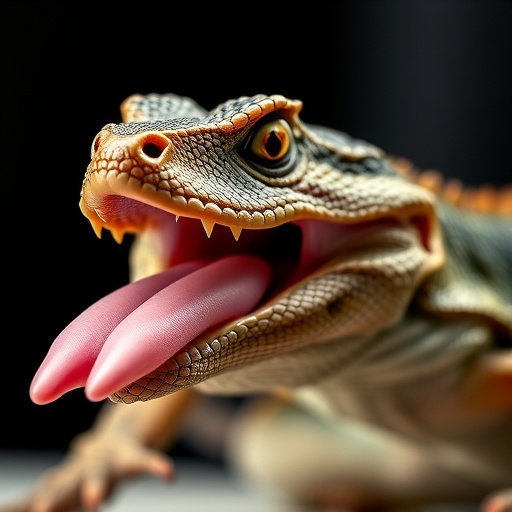In an unexpected convergence of evolution, researchers at the University of South Florida have uncovered a remarkable similarity in the tongue projection mechanisms of two vastly different vertebrates: salamanders and chameleons. Despite diverging millions of years ago and thriving in vastly different environments—salamanders preferring damp, terrestrial habitats such as rivers and leaf litter, and chameleons occupying warm, arboreal niches—both groups have independently evolved a ballistic tongue-firing system that operates with astonishing mechanical efficiency. This discovery, recently published in Current Biology, not only reshapes our understanding of vertebrate biomechanics but carries profound implications for bioinspired engineering and technology development.
The research team, led by postdoctoral researcher Yu Zeng and integrative biology professor Stephen Deban, employed decade-spanning high-speed video analysis to investigate the kinematics of tongue projection in these animals. They observed that both salamanders and chameleons can deploy their tongues at speeds reaching an impressive 16 feet per second. This “slingshot” mechanism relies not on specialized, exotic tissues but rather on the common vertebrate anatomical components—ordinary muscle, tendons, and bone—maximizing elastic energy storage and rapid release during tongue projection.
At the heart of this convergent evolutionary adaptation lies a complex interplay of linear actuators fashioned by the arrangements of tendinous and muscular structures. These biological systems act as capacitors of mechanical energy: muscles slowly preload elastic tissues, which then release energy in rapid, power-amplified bursts that propel the tongue towards prey with breathtaking speed. The analogy to a slingshot is precise—not merely visual but mechanistic—representing a unifying biomechanical strategy that transcends evolutionary distance.
This discovery expands the field of bioinspiration by illustrating how seemingly mundane biological tissues, when arranged in specific configurations, can produce extraordinary functional outcomes. Unlike more commonly studied systems that evolve novel materials or structures, these animals showcase how evolutionary ingenuity can arise from novel usage of ubiquitous anatomical elements. For engineers, this indicates a potentially fertile avenue for developing scalable linear actuators using widely available materials in biomedical devices or robotics.
From an engineering perspective, the implications are profound. The USF team is already exploring how to translate these biomechanical principles into practical applications. The capacity to generate fast, precise, and scalable motion could revolutionize medical instruments designed to navigate delicate bodily environments. For instance, devices inspired by this mechanism could clear vascular blockages by deploying rapid, controlled protrusions without requiring bulky or rigid components.
Beyond medicine, the implications stretch to disaster recovery and space exploration. Tools modeled after the ballistic tongue actuators may retrieve objects from collapsed buildings or grab debris in space, operating effectively in environments where dexterity, speed, and delicacy are critical. The scalability of the design—from millimeter-scale biomedical devices to meter-scale robotic appendages—makes it a versatile engineering template.
Biomechanically, the convergence observed challenges previous conceptions about how evolutionary pressures influence anatomical innovation. While chameleons and salamanders occupy distinct ecological niches and differ widely in their phylogenetic lineage, they converged upon functionally analogous mechanical solutions—highlighting nature’s economy in reusing successful designs. This convergence also provokes questions about the evolutionary pathways and genetic mechanisms leading to such analogous morphologies in distantly related lineages.
Further investigations by the research group aim to delineate the muscular and tendinous dynamics involved in tongue retraction—a phase as important and rapid as effectuation of the strike. Understanding the feedback and control mechanisms that govern retraction could unlock additional bioinspired approaches to designing fast-resetting actuators and compliant robotic systems. These insights form part of a growing scientific movement embracing “bioinspiration,” where lessons drawn from evolutionary solutions guide novel technological advances.
Professor Deban, reflecting on decades of study into animal locomotion and biomechanics, emphasizes the fusion of biology and engineering as a powerful driver of innovation. Whereas earlier work focused largely on cataloging and understanding biological performances, current efforts aim to decode and adapt these strategies into technologies that meet emerging human challenges. This bridging of disciplines is emblematic of a broader trend in science—embracing interdisciplinarity to accelerate discovery and application.
Video analyses and mechanical modeling underpin the robustness of the USF team’s findings. By positioning salamanders and chameleons side by side within experimental protocols, the researchers generated a comparative framework that revealed both the similarities and nuances in function, timing, and morphology. This integrative approach, leveraging biology, physics, and engineering, exemplifies the increasingly collaborative nature of modern scientific inquiry.
The study not only enriches evolutionary biology but also invites reexaminations of other systems where convergent mechanical strategies might be hiding in plain sight. It encourages cross-taxonomic comparisons and fuels curiosity about the latent possibilities residing in common anatomical components across life forms. Such work demonstrates how transformational discoveries often emerge at the intersection of disciplines and perspectives.
In sum, the University of South Florida’s groundbreaking work on the ballistic tongues of salamanders and chameleons is a testament to the power of fundamental research married to visionary application. The team’s elucidation of a shared evolutionary design packaged within everyday biological materials paves new pathways for technological innovation inspired by the living world. As bioinspired engineering continues to evolve, such discoveries will undoubtedly inspire the next generation of adaptive tools, devices, and machines capable of solving complex problems both on Earth and beyond.
Subject of Research: Animals
Article Title: Convergently evolved linear actuators in ballistic tongues
News Publication Date: 8-Sep-2025
Web References:
- Study published in Current Biology: https://www.cell.com/current-biology/fulltext/S0960-9822(25)01030-9?rss=yes
- Deban Laboratory website: https://sites.google.com/view/debanlab
- Researcher Yu Zeng’s page: https://yuzeng.org/
- University of South Florida: https://www.usf.edu/index.aspx
Image Credits: Credit: USF
Keywords: Evolutionary biology, Biomedical engineering, Mechanical engineering




